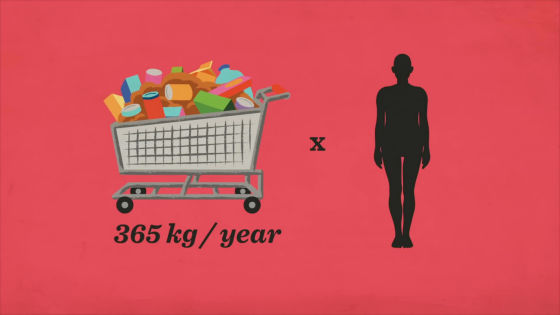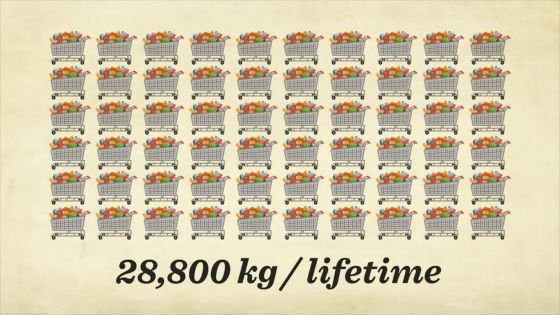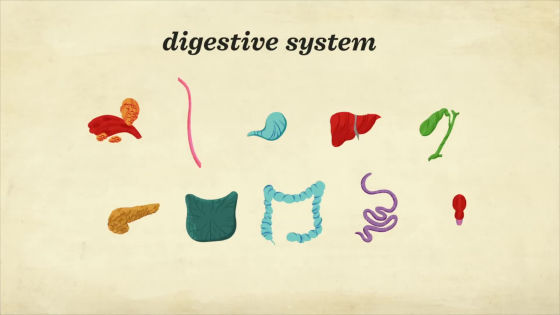How does our body digest food? "How your digestive system works" that easy-to-understand explanation with animation

Humans consume more than 365 kg of food in a year, and the organs are digesting food without taking a rest every day. However, it is unexpected to know what is going on in my body. Publish learning moviesTED-EdIs making it an animation that makes such a wonder of the human body easy to understand.
How your digestive system works - Emma Bryce - YouTube
Humans eat 1 to 2.7 kg of food a day.

Calculated in one year, the meal amount per capita is 365 kg or more.

The amount of food that humans consume in their lifetime is over 28,800 kg.

These foods will pass through a digestive organ consisting of ten organs.

Its length is 9 m long and consists of over 20 types of cells specialized for each function.

The role of the digestive system is to convert ingredients into nutrients and energy necessary for human beings to survive.

There are four parts of the gastrointestinal division.

One is the gastrointestinal tract. The gastrointestinal tract that transports food has a surface area of 30 to 40 square meters, about a badminton coat.

The second part is a part that decomposes food by special liquid such as pancreas · gallbladder · liver.

The third part is enzyme, hormone, nerve, blood, etc. They collaborate to break up the food ... ...

Adjust digestion process.

And finally made nutrients and energy are delivered to the body.

The fourth part isMesentery. The mesentery supports the gastrointestinal tract to fit in the place where the abdomen should be.

Actually "digestion" has begun before food touches the tongue. Saliva will start to emerge from salivary glands by imagining the taste.

The amount of saliva secreted by humans on a day is about 1.5 liters.

When bathed food and saliva mix, it becomes state called bolus. Enzymes are contained in saliva, and decomposition of starch begins here.

After that, food goes through a pipe called esophagus that is about 25 cm.

The esophagus feels that a bolus exists,PeristalsisI will carry food by raising it.

Food entering the stomach bounces off by the work of the muscle ......

It is crushed finely.

Instructs the hormone lined up in the cells to release the gastric juice that contains a lot of acid and enzymes, food is further finely decomposition, also begins the decomposition of protein.

These hormones send messages to the pancreas, liver and gallbladder to secrete digestive juice.

It also instructs to send bile that breaks fat in the next step.

By staying in the stomach for about 3 hours, the bolus turns into an itchy object called Chimes, allowing it to pass through the narrow intestines.

In the next step, the liver who received the bile from the gall bladder sends digestive juice to the beginning of the intestine called the duodenum.

Here, fat contained in Chimes will be decomposed. This work makes digestion with pancreatic juice and intestinal juice easier.

Enzyme-rich digestive juice is a molecule of fat ......

Decomposes into fatty acids and glycerin which the body is easy to absorb.

The digestive juice also decomposes proteins into amino acids.

Furthermore, carbohydrates are broken down into glucose.

The above process is a small intestineJejunumYaileumIt is done in a very low position.

The intestines doing these tasks have millions of small protrusionsSoft lugIt is covered with.

The soft protrusions make the intestinal surface area enormous, maximizing absorption of molecules and transport to the blood.

Blood receives molecules through soft protrusions and delivers nutrients to the organs and cells of the whole body. However, the process of digestion is not the end here.

Dietary fiber, water, dead cells, etc. remain.

The large intestine sucks off these moisture ... ...

A flight will be made.

When the stool is carried to the rectum by the large intestine, the nerve feels pressure and tells the body that "It is time to eliminate unnecessary things". And by-products of digestion will be discharged through the anus.

Finally, the digestive process is finished. The journey of digestion of foods is going to take place in about 30 to 40 hours.

Related Posts:







